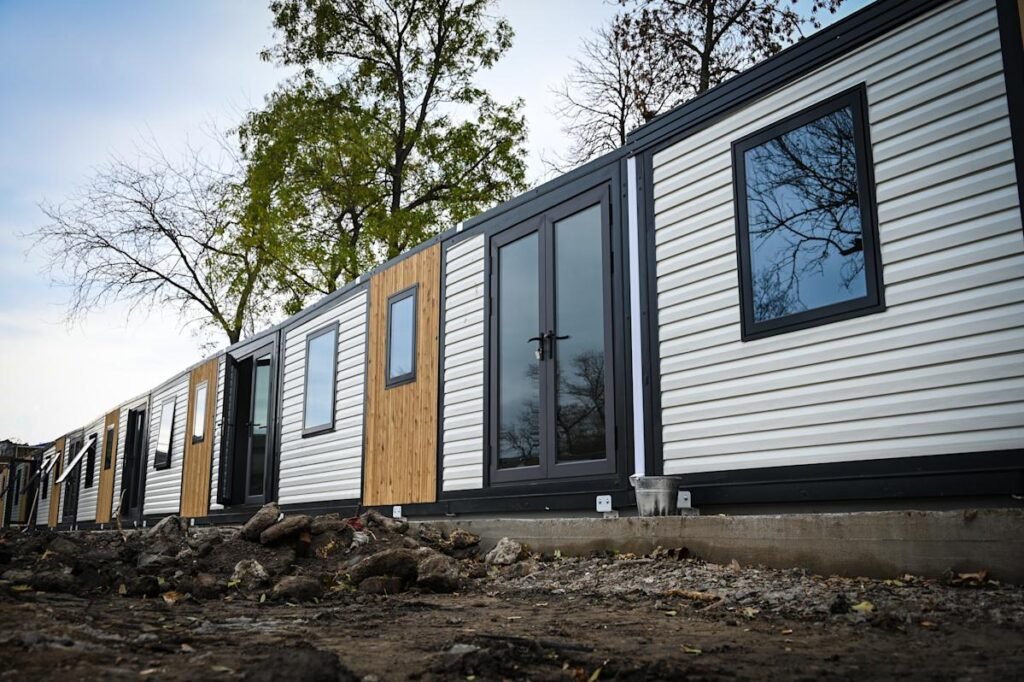Buying a modular or manufactured home could make homeownership more affordable. Some people use the two terms interchangeably, but they’re not one and the same. Here’s how a modular home compares to a manufactured one, including key differences, advantages, and drawbacks.
A modular home is a type of house constructed in pieces (also known as modules) in a factory. Manufacturers then ship modules from the factory to a permanent lot, where a home construction crew finishes building the home.
Once the pieces for a modular home arrive at their permanent address, the construction process looks quite similar to a stick-built home — one that’s built on-site from the ground up. A team of home builders, electricians, and utility technicians collaborates to affix the home to its foundation, complete the final construction of the house, and ultimately connect the utilities, ensuring the new owner walks into a beautifully constructed, brand-new home.
-
The amount of building completed at the factory. Modular homes are 70% to 90% complete when they ship from the factory to their permanent building site.
-
How factories reduce build times. Since modular home factories are climate-controlled environments, the building process can continue year-round, reducing build times over stick-built homes subject to Mother Nature’s whims.
-
Level of customization. Modular home manufacturers offer buyers the ability to customize a wide range of features, from the floorplan and flooring to bathroom and kitchen fixtures.
-
Building standards. Like stick-built single-family homes or multifamily homes, modular houses must meet state and local building codes, which are generally more stringent than federal codes.
-
They’re not new. Sears started selling modular home kits as early as 1908.
-
The final look. Once the building process is complete, telling a modular home from a stick-built one may be impossible.
A manufactured house is constructed in a factory on a steel frame and then transported to the owner’s site. This type of home is the next generation of what was once called a mobile home. Mobile homes typically were affixed to a wheeled foundation, which made them easier to move. However, today’s manufactured homes differ because they’re generally built to only move once — from the factory to their final location.
Once a manufactured home arrives at the owner’s desired location, the steel frame is attached to a permanent lot or foundation, often in a neighborhood explicitly designed for homes of this type. You can buy or lease a lot in one of these communities, with access to pre-installed utilities and amenities. You can also install your home on a regular residential lot and arrange for utilities to be established and connected.
-
They come in multiple sizes. Manufactured homes can be single-wide, double-wide, or triple-wide, offering buyers the options for smaller and larger homes.
-
How spacious they can be. Manufactured home floorplans can be as cozy as 500 square feet for a single-wide one-bedroom or up to 2,500 square feet for a triple-wide with three or more bedrooms.
-
Level of customization. Buyers can choose upgraded features like cabinetry, fixtures, lighting, and flooring.
-
Building standards. These homes are built to federal codes mandated by the U.S. Department of Housing and Urban Development (HUD).
Read about how to get an FHA loan for a manufactured home.
Despite their shared factory origins, there are key differences between modular and manufactured homes that are crucial for any home buyer to consider.
Just running the numbers, manufactured homes are more cost-effective when purchased new than modular homes. The Manufactured Housing Institute cites that manufactured homes have an average cost of $85 per square foot.
At the same time, figures from HomeAdvisor put the average cost of modular homes between $80 and $160 per square foot, including installation and delivery. However, customizations to both home types can increase costs.
There are pretty big differences in how you finance these homes. Regardless of the one you choose, your creditworthiness will be a leading factor in how much you pay.
You can use a traditional mortgage to purchase a modular home, much like you would a site-built one.
For a new build, you’ll need a construction loan, which you can convert to a permanent mortgage once the project is complete. Construction-to-permanent loans convert automatically.
Manufactured homes can come with fewer financing options, especially if they’re not affixed to land.
Movable manufactured homes are classified as personal property, not real estate. For these, you may have to use a chattel loan or a personal loan — both of which can have lower loan limits and shorter repayment terms. A manufactured home permanently affixed to the property may qualify for more traditional mortgage options.
Now that you’ve seen how modular versus manufactured homes compare, it’s time to weigh which type of house might best fit your homeownership goals. The one you ultimately choose will likely depend on several different factors. Here are some points to consider on your path to buying a home.
-
You have a bigger budget. Modular homes tend to have higher price tags than manufactured homes.
-
You have custom-built dreams. With a wide range of styles and floor plans available, a modular home could give you the custom-built aesthetic you’ve always wanted.
-
You want more lender flexibility. Since you can finance modular homes using conventional construction loans, you can shop with various mortgage lenders to find the best rate.
-
You have a lower budget. The average sales price of a new manufactured home in the U.S. as of April 2025 was $88,500.
-
You don’t already own land. Manufactured homes offer the ability to rent your lot.
-
You prefer a minimalist lifestyle. Manufactured single-wides offer smaller floor plans that can keep living simple.
A modular home could be better than a manufactured home if one of your goals for buying a home is to build wealth. Since modular homes are nearly indistinguishable from their stick-built counterparts once constructed, they’re more likely to hold their value and appreciate just like any other home. Manufactured or “mobile” homes are more likely to depreciate, especially if you decide to park yours in a mobile home park where you don’t own the land.
What is the difference between a modular home and a regular home?
The difference between a modular home and a regular home is that modular homes are primarily factory-built. Once the key components are built, those parts are transported to and assembled on the home’s permanent lot. Regular, or stick-built homes, are constructed from the ground up on the home’s permanent lot.
What is the difference between a double-wide and a modular home?
The difference between a double-wide and a modular home is that the former is a type of manufactured house. A double-wide would be considered a manufactured home made of two separate, fully constructed units combined to create one home. A modular home is constructed of multiple factory-made modules shipped to a permanent site where construction is completed. Modular homes can be multiple stories since modules can be designed to stack on top of each other during the final construction process.
Laura Grace Tarpley edited this article.
Read the full article here












